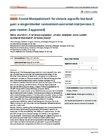| dc.contributor.author | Branchini, Mirco | |
| dc.contributor.author | Lopopolo, Francesca | |
| dc.contributor.author | Andreoli, Ernesto | |
| dc.contributor.author | Loreti, Ivano | |
| dc.contributor.author | Marchand, Aurélie | |
| dc.contributor.author | Stecco, Antonio | |
| dc.date.accessioned | 2024-02-13T14:37:54Z | |
| dc.date.available | 2024-02-13T14:37:54Z | |
| dc.date.issued | 2016-01-08 | |
| dc.identifier.citation | Branchini, M., Lopopolo, F., Andreoli, E., Loreti, I., Marchand, A. M., & Stecco, A. (2016). Fascial Manipulation® for chronic aspecific low back pain: a single blinded randomized controlled trial [version 2; peer review: 2 approved]. F1000Research, 4, 1208 . https://doi.org/10.12688/f1000research.6890.2 | en |
| dc.identifier.issn | 2046-1402 | |
| dc.identifier.uri | https://aecc.archive.knowledgearc.net/handle/123456789/268 | |
| dc.description | Available under License - Creative Commons Attribution: https://creativecommons.org/licenses/by/4.0/ | en |
| dc.description.abstract | Background: The therapeutic approach to chronic aspecific low back pain (CALBP) has to consider the multifactorial aetiology of the disorder. International guidelines do not agree on unequivocal treatment indications. Recommendations for fascial therapy are few and of low level evidence but several studies indicate strong correlations between fascial thickness and low back pain. This study aims at comparing the effectiveness of Fascial Manipulation® associated with a physiotherapy program following guidelines for CALBP compared to a physiotherapy program alone.
Methods: 24 subjects were randomized into two groups, both received eight treatments over 4 weeks. Outcomes were measured at baseline, at the end of therapy and at a 1 month and a 3 months follow-up. Pain was measured with the visual analogue scale (VAS) and the brief pain inventory (BPI), function with the Rolland-Morris disability questionnaire (RMDQ), state of well-being with the short-form 36 health-survey (SF-36). The mean clinical important difference (MCID) was also measured.
Results: Patients receiving Fascial Manipulation® showed statistically and clinically significant improvements at the end of care for all outcomes, in the short (RMDQ, VAS, BPI) and medium term for VAS and BPI compared to manual therapy. The MCID show significant improvements in the means and percentage of subjects in groups in all outcomes post-treatment, in the short and medium term.
Conclusion: Fascial tissues were implicated in the aetiology of CALBP and treatment led to decreased symptomatic, improved functional and perceived well-being outcomes that were of greater amplitude compared to manual therapy alone. | en |
| dc.language.iso | en | en |
| dc.publisher | F1000Research | en |
| dc.subject | Low back pain | en |
| dc.subject | Thoracolumbar fascia | en |
| dc.subject | Myofascial pain | en |
| dc.subject | Nonspecific pain | en |
| dc.title | Fascial Manipulation® for chronic aspecific low back pain: a single blinded randomized controlled trial [version 2; peer review: 2 approved] | en |
| dc.type | Article | en |
| dc.identifier.doi | https://doi.org/10.12688/f1000research.6890.2 | |
